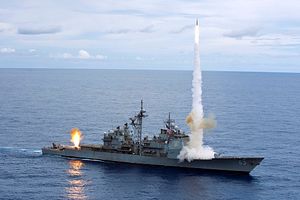So who won the December 5 encounter between the Aegis cruiser USS Cowpens and the ships escorting aircraft carrier Liaoning? Sad to say, methinks this round goes to China’s navy. So, evidently, does Beijing, which has struck an upbeat note since the press disclosed the near-collision last week. Magnanimity bespeaks comfort with the outcome.
Think about it. PLA Navy vessels barred Cowpens, one of the U.S. Navy’s premier surface combatants, from what Chinese spokesmen call an “inner defense layer” centered on Liaoning. Inner defense layer? Forsooth. This exclusion zone was a circle with a diameter at least 60 miles across. It spanned over 2,800 square miles. To use a yardstick wearisomely familiar to us Rhode Islanders, that’s over twice the area of our beloved Ocean State. After the American warship maneuvered radically to avoid colliding with a PLA Navy amphibious transport that crossed her bow at close quarters, officers on board the two ships reportedly conferred by radio. Cowpens then left the proscribed area.
Here’s how Xinhua describes the encounter: “U.S. missile cruiser Cowpens, despite warnings from China’s aircraft carrier task group, broke into the Chinese navy’s drilling waters in the South China Sea, and almost collided with a Chinese warship nearby.” Get the cause/effect relationship being alleged here? American ship “breaks into” Chinese formation, as though its crew jimmied the lock on a gate. Clumsily, it almost hits a Chinese ship. American ship is warned to leave. American ship leaves. Score one for the forces of truth, justice, and the Chinese Communist way!!! That’s the tale Chinese officialdom is spinning: that the PLA Navy can sketch an area far larger than any naval formation, forbid others to enter that area, and drive off anyone uppity enough to intrude.
How can others debunk Beijing’s version of events? They first have to acknowledge that the symbolism of such encounters matters. The U.S. and allied navies should study the December 5 incident, and learn. This was an incremental setback not just for the U.S. Navy as Asia’s foremost sea service, but for the cause of freedom of the seas. Such setbacks could add up to a major defeat over time, lending credence to the notion of American decline while loosening the U.S.-led alliance system. That’s doubtless the point for China’s leadership.
But wait. Can you really win an engagement in which no rounds leave the barrel, the rail, or the vertical launcher? How do you know whether you won, lost, or fought to a draw?
As usual, consulting the classics represents the beginning of wisdom. Prussia’s favorite son, Clausewitz, reminds posterity that certain military endeavors carry direct political effects. They can “disrupt the opposing alliance,” for instance, or “paralyze it,” or “gain us new allies,” or “favorably affect the political scene.” Nor must an actual exchange of fire take place for such happy effects to accrue. Adds Clausewitz, “the outcome rests on the assumption that if it came to fighting, the enemy would be destroyed.” “Consequently,” he concludes, “all action is undertaken in the belief that if the ultimate test of arms should actually occur, the outcome would be favorable” (Carl’s italics).
In short, whoever observers think would’ve won in wartime wins in peacetime. This is a point familiar to readers of Edward Luttwak’s Political Uses of Sea Power a work composed in the bad old days when U.S.-Soviet high-seas run-ins resembling that between Cowpens and Liaoning were commonplace. It matters little who the stronger navy might be. Spin doctors can skew the verdict one way or the other. Understanding that is the first step toward counteracting the spin.
Some other recommendations. One, confer with Chinese leaders about the rules of engagement when Chinese and American forces operate in proximity to each other. Consult privately if possible.
There’s precedent for such low-key diplomacy. For instance, Teddy Roosevelt deployed virtually the entire U.S. Navy battle fleet off Venezuela in 1902 to deter a European fleet from seizing territory there. So circumspect was TR that historians argued for a century about whether Admiral Dewey’s cruise actually took place. (It did. I think.) He deterred without humiliating excitable authoritarian leaders like Wilhelm II. One hopes such behind-the-scenes outreach explains the week’s delay between the Cowpens incident and the time the news broke. One can hope.
Two, film all close encounters with the PLA Navy from as many angles as possible. Facts are disinfectants. If Beijing insists on waging a war of public perceptions — as well it may — then report the facts and let important audiences judge where the truth lies.
Three, give no ground on matters of principle. It’s harder to restore freedoms once lost than to preserve them in the first place. Surrendering maritime rights — by increments, for momentary amity — is no way to run an Asia policy.
And finally, prepare for a protracted struggle. This battle of narratives will not end soon. That the United States and its navy must return to history, after a two-decade strategic holiday is a hard message to accept. But accept it we must.
China wins by default if America declines to compete.

































